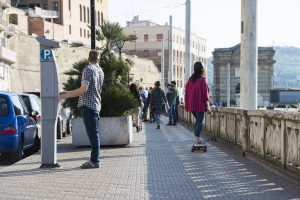To address climate change, many of us need to reduce our “carbon footprint.” But what are truly low-carbon lifestyles, and can they really be achieved through personal choices alone?
Surveys show that many people want to participate in climate action, but putting low-carbon living into practice can be complicated- it can mean changing different aspects of daily life, particularly for the wealthier parts of society.
In some high-emitting countries, even this may be difficult: in the United States, Canada, and Australia, for example, per capita emissions stand at 16-17 tons of CO2e per year.
An Oxfam report in 2021 found that by 2030 the global average of emissions will need to stand at only 2.3 tons of CO2 per year to keep global warming below 1.5°C (the report did not cover other greenhouse gases), compared to the current average of 4.6 tons.

It is very difficult to live with low carbon emissions if the products, society, and infrastructure around us are all high emitters. In fact, few would argue that people should achieve these levels by individual action alone: much of the products, infrastructure, systems, and policy decisions that influence our lives must also change to reduce emissions.
However, a false dichotomy can be created in discussions of individual versus system behavior change.
We need both individual and system changes: government policies, societal preferences, and consumer behavior can influence each other.
Change our Lifestyles
According to the Intergovernmental Panel on Climate Change (IPCC), with the right policies, infrastructure, and technologies to change our lifestyles and behaviors, we can substantially reduce overall greenhouse gas emissions by 2050. The IPCC also states that the world must achieve net zero emissions with limited overshoot by 2050 to keep global warming below 1.5 C.
In wealthier countries, this means moving to a low-carbon lifestyle for most people. But the changes to get there are not necessarily painful or even negative. For example, research has shown that good public services enable greater well-being for less energy consumption.
One important change would be to change the way we get around
A combination of public transportation and micro-mobility systems (such as electric skateboards) make it efficient and effective for people to move around. Private cars, with their huge emissions and often empty seats, would largely be a thing of the past, and parking lots would be converted into green public spaces where people go to play, relax, or exercise.
The public transportation of the future will be eventually electrified and powered by renewable sources. It would be complemented by bicycling and walking and other forms of mobility that make people active, benefiting well-being and health.

Food and things
A major 2019 report on “Diet for the Health of the Planet” aimed to define the optimal diet to balance the health of people and the planet. The report recommends that meals consist of about half a plate of fruits and vegetables and plenty of legumes and nuts. Vegan and vegetarian diets can help meet these requirements, but meat and dairy products can still be incorporated.
Visualizza questo post su Instagram
The Problem with Stuff
We might consume more cultural experiences (think festivals, trips to the theater, or dance classes), but in terms of stuff, anything that has weight, anything that is produced with matter and energy, we should consume less of it.
This is not a plan to get rid of all our electronics and clothing, but a world in which their production is based on renewable electricity and not fossil fuels, in which better quality and longer-lasting products take center stage, and in which we simply buy less of them. This also means a greater focus on repairability and recycling, rather than buying a new phone every year or so.
Sandra Goldmark, director of Campus Sustainability and Climate Action at Barnard College and theater professor recommends looking for good materials design, and repairability. In her new book, Fixation, Goldmark, wrote, “Good stuff is well designed for a long life cycle, made of the right materials, has parts that are easily available and replaceable, and was produced in a socially and environmentally ethical process.”
The European Union has already adopted a “right to repair” for consumer products that aims to ensure that more products are repaired within the legal warranty and to provide citizens with better options for repairing products that are technically repairable, even if they are outside the warranty. Measures like this can help begin to build a “repair economy” by requiring companies to make their products repairable and to make manuals and parts available at an affordable price.
Linky Innovation supports the circular economy and it is at the heart of our business model. Linky, the foldable electric skateboard, has been designed following the Design for Disassembly (DfD) approach, a process by which the design is implemented so as to allow for easy and economically sustainable disassembly of the product at the end of its life, and the reuse and/or recycling of its most valuable components.
Once the customer is finished with Linky, they can send it back to us and we can remove the damaged parts without having to throw away the entire product. This will be a game changer for reconditioning and giving the product a new life.
What are the carbon-free activities you could do?
You can meditate, be in nature, just stop doing things and absorb the world, smell flowers, go foraging, art, walking, cycling, gardening, or go for a skateboard ride. Listening or playing music, singing, dancing, all the things we did as kids: these are things that we had a great love of.

What are your favorite carbon-free activities?
Drop your comments below! we’d love to hear your opinions 🙂

